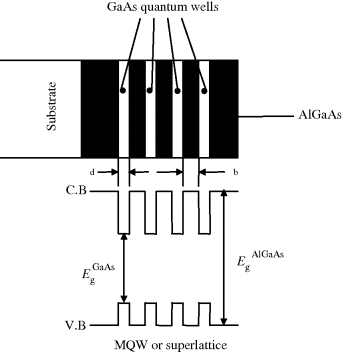3.4 Superlattices
A repetition of the layer sequence to produce a single QW leads to a multiple QW (MQW) structure, as shown in Figure 3.10. The individual QWs in MQWs are uncoupled and therefore the energy levels remain discrete, with values given by Eq. (3.10) for infinite barrier.
Figure 3.10 Schematic diagram of a semiconductor multiple QW (MQW) or a superlattice.

Coupling between adjacent wells may take place in a number of ways. If the barrier layer thickness is small or the barrier height is low or if both of them are effective, then the exponential tails of the envelope functions as shown in Figure 3.5 in two wells overlap, giving rise to coupling. The situation is analogous to two mutually coupled tuned circuits. When the coupling is strong, the resonant frequency breaks into two well-separated peaks. For two coupled wells, the coupling leads to two closely spaced energy levels centered about the original degenerate energy level. The presence of N number of coupled wells gives rise to a similar number of closely spaced energy levels. When the spacing between the levels is small, the levels are almost continuously distributed and an energy band, called the miniband, is formed.
The periodic potential in a superlattice is shown in Figure 3.10. The simplest method of obtaining the eigenvalues and envelope functions for this case is to employ the well-known Kronig–Penney model ...
Get Silicon Photonics: Fundamentals and Devices now with the O’Reilly learning platform.
O’Reilly members experience books, live events, courses curated by job role, and more from O’Reilly and nearly 200 top publishers.

